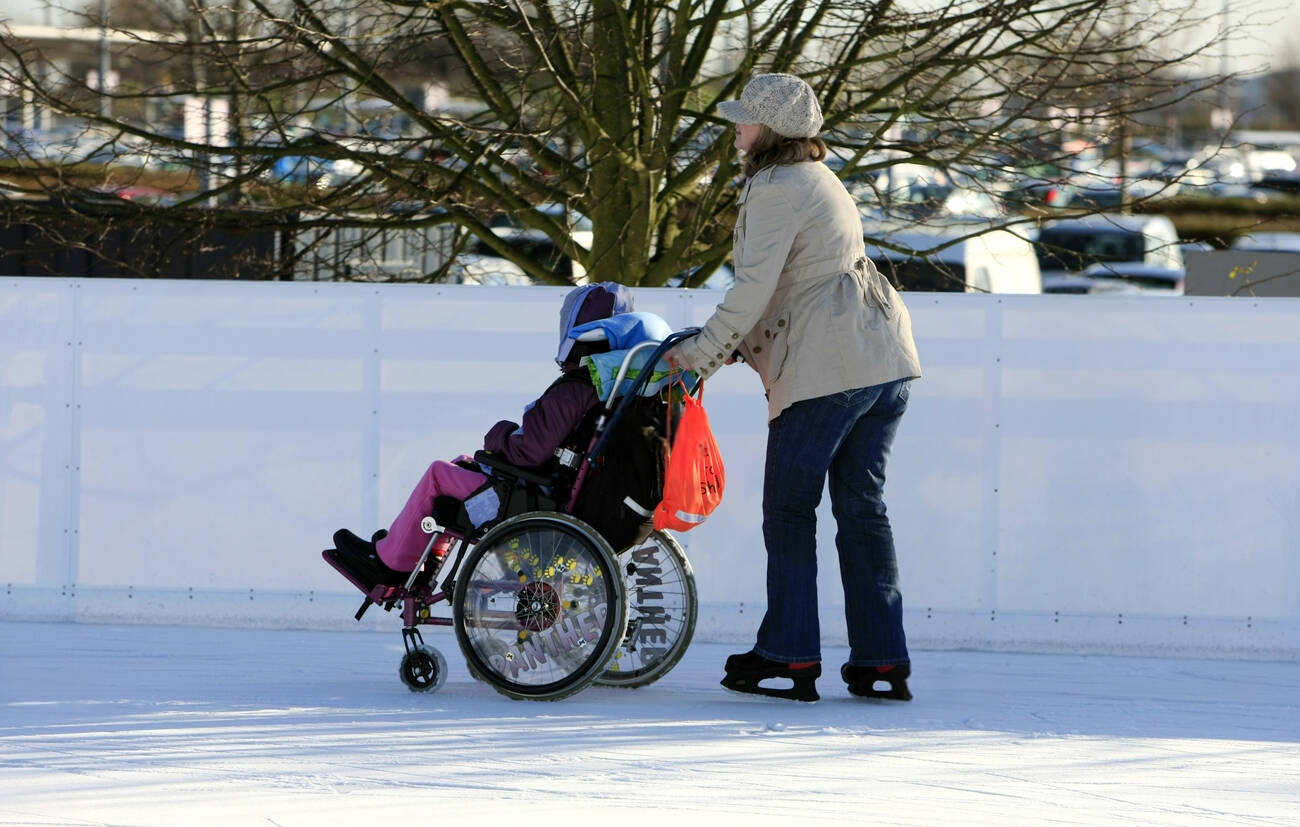When Alina was younger, winter nights meant hot chocolate and flickering television screens filled with sweeping music and glittering costumes. She pressed her face against the glass, eyes wide as Olympic champions soared across the ice, spinning and leaping as though gravity were merely a suggestion.
“I want to twirl like that, Daddy,” she’d whisper, her small finger tracing invisible loops in the air. I’d crouch beside her and tuck a stray lock of hair behind her ear. “Someday, sweetheart,” I’d say, offering a comforting smile I could almost believe.
But “someday” lived in a future I feared would never come.
Early Years and Unseen Battles
Alina entered our world with a shock—a rare neuromuscular disorder that rendered her body whisper-thin and her bones fragile. We learned her diagnosis in a sterile hospital room, the walls humming with machines that pulsed hope and dread in equal measure. She lay in my ever-shaking arms, too small to hold my tears back.
Milestones that other parents took for granted—first steps, first words—were replaced by tube feedings and daily physical therapy. She required oxygen support through tiny tubes at night, the gentle hiss a lullaby of vigilance. I counted hospital overnight stays in my sleep, the antiseptic scent followed me home. Still, each time a strap of her stroller was adjusted or a feeding bag refilled, I marveled at her resilience.
A Promise Beyond Words
Seven winters later, Alina sat in her custom stroller, watching ice skating shows with familiar longing. Though silent and bound by monitors, her heart spoke: every well-rehearsed performance ignited a spark. I resolved then—not in platitudes but in action—to bring her to the ice.
By January, when thin daylight crept into our living room, we set our plan: blankets to ward off the cold, secure the IV, pack oxygen canisters, and roll—my heart pounding—onto the rink.
I. Stepping Onto the Ice
The moment we crossed the threshold, murmurs pulsed around us. Fathers in full gear paused mid-stride; teenagers filming their tricks lowered their phones.
A young man approached. “Need help?” he asked, voice kind but uncertain.
“No,” I replied firmly. “We’re here to glide.”
My skates, decades untouched, felt foreign beneath me as I pushed Alina around the perimeter. Each slow rotation carried a blend of fear and exhilaration—her wide eyes, the hum of her monitor, my breath visible in the crisp air.
Her small hand, pale against her blanket, reached for mine. Warmth spread from my fingers to my chest. In that grasp, all my doubts and every whispered “someday” melted away.
II. Crafting Community in Cold
Week after week, we returned. Familiar faces greeted us: “There’s Alina!” a teenage girl would shout. Skaters waved, offering cheers that warmed the arena.
One volunteer, an older woman with silver hair and bright mittens, skated alongside us and said, “Your daughter reminds me to find wonder in every spin.”
Her words fell like soft snowflakes, whispering that inclusion can begin with a single stride. Soon, rink management invited us to a quiet morning session—lighting dimmed, music gentle—ensuring Alina could experience ice without the swirl of crowds.
III. When the World Noticed
A video of our first glide—choppy, heartfelt, unarranged—surfaced online. Comments streamed in: messages of solidarity from parents of children with disabilities, offers of advice from adaptive sports coaches, nostalgic notes from grandparents wishing they’d tried something brave for their little ones.
One message stood out: Dr. Sofia Martinez, a physiotherapist specializing in aquatic therapy, wrote that she had a pilot program in the local pool and wondered if Alina might benefit. Hope flickered: water, she explained, could become Alina’s second ice—soft, supportive, limitless.
IV. Waterborne Possibility
Skeptical but driven, we joined the program. The community pool’s chlorinated scent and warm light replaced the ice’s chill. Alina entered the water in a buoyant sling, her legs suspended in forgiving calm.
Week after week, she pushed against gentle resistance, her arms tracing circles in warm blue. Therapists guided her through exercises disguised as games—bubbles to chase, foam noodles to weave between. Slowly, I witnessed her muscles respond: a new bend at the knee, a curious reach of her ankle. Each small movement arrived like a gift we’d almost forgotten to open.
V. Milestones Etched in Water and Ice
Back on dry land, Alina began to surprise us: a twitch in her finger as she reached for my hand, a flex of her toes when music played. One afternoon, with careful support, she stood in her braces for a heartbeat—eyes bright as the first time she tasted ice cream. I could only say, “You’re doing it,” over and over, tears falling like heavy raindrops.
VI. The Return to Ice
On her tenth birthday, we arranged a special session. Alina, helmeted and hopeful, stepped onto the rink not in her stroller but in her braces.
We held hands. One, two, three tentative steps. Skates scraped the ice. Her laughter rang out—a clear, joyous bell I’d longed to hear. Around us, skaters cheered: strangers transformed into family in the glow of her triumph.
VII. Voices of Expertise
Dr. Sofia Martinez, on aquatic therapy:
“Water unloads the body weight, allowing children to explore movements with less fear. Over time, these positive experiences translate into stronger neuromuscular pathways on land.”
Dr. Michael Harper, pediatric rehabilitation specialist:
“Integrating meaningful goals—like skating—into therapy nurtures intrinsic motivation, amplifying progress far beyond standard exercises.”
VIII. Reflections on Resilience and Love
This journey reframed my understanding of possibility. It revealed that hope isn’t a distant star but a flicker we carry into every unexpected moment: the first squeeze of a hand, a child’s genuine smile, the kindness of a stranger believing in dreams.
Alina’s steps—each small, deliberate push—embodied the power of unwavering love.
IX. Guideposts for Families
1. Blend Joy with Therapy: Find activities that speak to your child’s passions to fuel persistence.
2. Seek Specialized Support: Research innovative programs—adaptive sports, aquatic therapy, community initiatives.
3. Build Your Village: Share your story, connect with local groups, invite community members to participate.
4. Celebrate the Small: A single twitch, a coo of delight—cherish every milestone.
5. Advocate for Inclusivity: Encourage recreational venues to create adaptive sessions or quiet hours.
X. A Call to Compassion
If Alina’s story stirs your heart, please share it. Let’s champion more inclusive spaces—where every child, regardless of ability, can chase dreams across ice, in water, or anywhere their spirit calls them to soar.

Lila Hart is a dedicated Digital Archivist and Research Specialist with a keen eye for preserving and curating meaningful content. At TheArchivists, she specializes in organizing and managing digital archives, ensuring that valuable stories and historical moments are accessible for generations to come.
Lila earned her degree in History and Archival Studies from the University of Edinburgh, where she cultivated her passion for documenting the past and preserving cultural heritage. Her expertise lies in combining traditional archival techniques with modern digital tools, allowing her to create comprehensive and engaging collections that resonate with audiences worldwide.
At TheArchivists, Lila is known for her meticulous attention to detail and her ability to uncover hidden gems within extensive archives. Her work is praised for its depth, authenticity, and contribution to the preservation of knowledge in the digital age.
Driven by a commitment to preserving stories that matter, Lila is passionate about exploring the intersection of history and technology. Her goal is to ensure that every piece of content she handles reflects the richness of human experiences and remains a source of inspiration for years to come.
